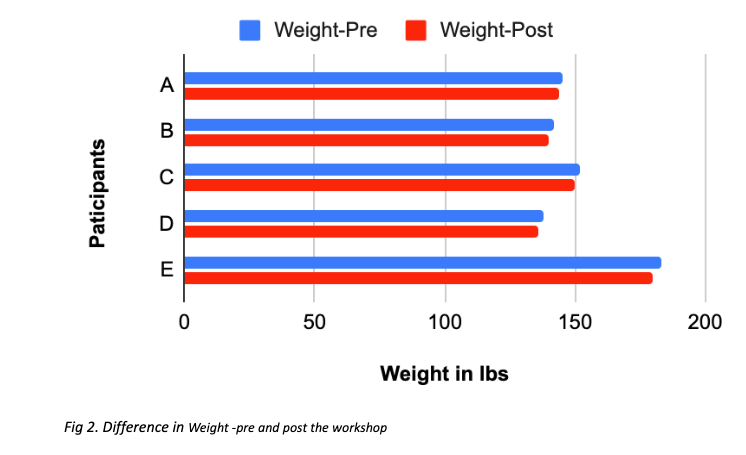Executive Summary
Abstract
This study is to observe the effects of yoga on the participants who have diabetes. SEWA, in the USA chapter, has been working in collaboration with Yoga Bharati to bring this opportunity free for interested people who want to take advantage of this workshop in understanding how yoga can help people with diabetes.
Methods
There were 11 participants in the workshop. Of them, 4 were men and 7 were women. 5 participants complete the pre-and post-assessments.
Results
There was an overall improvement in the quality of life including reduction of weight, waist circumference, and in one case, even reduction in the blood pressure.
Conclusion
We found out that Yoga for Diabetes Management and Metabolic disorders, even when practiced online for a short duration, helps in reducing waist circumference and building self awareness and improving quality of life.
Workshop Objectives
The main objective of this workshop is to help people manage diabetes therapeutically through SDM (Stop Diabetes Movement). The intent was also to provide group therapy and equip the participants towards the recovery of their normal function and increase their self confidence.
The other objective of this workshop was to spread awareness on diabetes and how a quality lifestyle can play an important role in keeping the diabetes at check.
Materials and Methods
Participants
There were 40 participants who had registered for this workshop. However, only 11 completed the health survey out of which 7 were women and 4 were men.
Design
The workshop took place over a 3 week period. Prior to the workshop, participants were asked to complete a self health assessment form. Sessions were conducted online and each session was 90 minutes long. In total, there were 4 sessions per week. An hour long information session by an endocrinologist and dietician was included, to explain underlying causes of diabetes and to bring balance to life with the consumption of healthy food.
Methods and Intervention
The design of yoga therapy included practices to increase the blood flow in the abdominal region and to activate the pancreas and metabolic system. Practices such as cleansing kriya, pranayama, MSRT(Mind Sound Resonance Technique) and other techniques involving twisting, compressing and stretching were given. This workshop focussed on providing relaxation and restorative techniques to enable the participants to move from sympathetic(fight or flight) mode to parasympathetic response.
As part of the workshop routine, initially, breathing practices like Sahaja Pranayama were used as a tool to direct the outward senses towards oneself. Eventually, the participants were taught to help bring the focus towards each and every sensation that they experienced. Participants were educated to understand the mechanics of breathing - Breathing is subconsciously controlled by the respiratory center at the base of the brain.
Slow and controlled movements which involve rhythmic breathing were practiced to calm down the rajasic(speedy) nature.
The focus was then brought towards the practices which would help in the stimulation of the pancreas and other abdominal organs.
Fast paced practices were given to increase the blood flow and to energize all the cells of the body.
Relaxation techniques like IRT, QRT and DRT were imparted in between the invigorating practices to bring deeper relaxation to the mind and body.
Kriyas like Kapalabathi and Agnisara Kriya, Bandhas like Uddiyana bandha were practiced to enhance metabolic functioning.
Concepts on mindfulness, stress, pancha prana, pranayama, Ayurveda, karma yoga were shared to understand how these things impact diabetes.
Participants were told that Yoga can be integrated as part of their lifestyle by using the above described techniques and weaving them into their routine.
Feedback from Participants
Atleast one participant reported regulated pressure and improved fasting blood sugar numbers.
One participant reported an improvement in their frozen shoulder
A couple participants reported that they lost weight.
Overall, people reported improvement in the quality of life.
Assessments
A Self Health Assessment form was used which included questions on the lifestyle, demography, and chronic conditions. Basic vital parameters such as height, weight, blood pressure, pulse, Fasting Blood Sugar, Total Cholesterol were also compiled as part of this assessment.
Data Analysis
Data was analyzed using Google spreadsheets comparing pre and post data and generating simple charts. Due to the nature of the project which was an observational and subjective study, this report focuses on Therapist observation, Assessment reports and individual feedback collection based on Post- Workshop informal interviews.
Results
Graphs were produced to show differences in pre and post data. The below graphs show the following:
A noteworthy decrease in participants’ weight of 1-3 pounds over the duration of the workshop
A highly commendable reduction of 1-4 inches in the circumference of the waist
A notable reduction of 2-8 inches in the circumference of the hip
A marginal improvement in the quality of the sleep pattern.
Effect of Yoga on Participants
Information on different concepts like stress, mindfulness, food etc helped the participants to have a larger picture on how these can have an effect on their level of diabetes/the quality of life.
A session of 90 mins duration was conducive to deepen the holistic practice.
Conclusion and Discussions:
Yoga for Diabetes Management and Metabolic disorders helps in reducing waist circumference and building self awareness.
Since the workshop did not have a compensation model to encourage participants to complete the workshop in its entirety and provide the post data. It was found that a lot of participants were irregular and/or didn’t complete the post health survey. The workshop should be extended to have a duration of 2-3 months to be able to make an impact on the participants and to study the results better.




